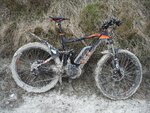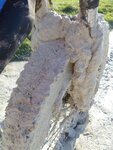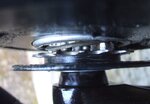A friend was recently talking about the Bosch drive system with me (he rides a lot of off-road terrain) and we were discussing the smaller front sprocket that the system uses (apparently this part gets built by the bike manufacturer but Bosch specs three sizes... all relatively small, ideal for higher speed racing, normal city riding and off road climbing). These smaller chain ring sizes (verses traditional larger sized front rings) seems to create mechanical advantage for their centerdrive motor, allowing it to spin at higher RPMs and achieve better torque and power as a result.
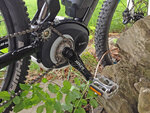
Okay, so this discussion is just setting the stage for one issue that my friend has experienced. Apparently in muddy situations he has found that the smaller chain ring and associated guide don't provide the necessary space or separation to avoid chain suck (which is when the bottom portion of the chain sticks to the sprocket and gets pulled up... possibly back into the top of the cog where the top portion of the chain is feeding in). He shared a picture with me recently and to be fair, since the sprockets are all made by the manufacturer and not Bosch, this may be a result of both the smaller mountain bike speck that Bosch recommends in their sizing guideline or simply the way the sprocket was made or possibly the addition of the small chain guide that hugs the front sprocket? Maybe the teeth on this particular sprocket were tighter than necessary? I discovered recently that Haibike actually uses a pattern of narrow to wide teeth that match the same pattern on the chain (it has narrow and wide slots from one link to the next) designed to reduce slipping and possibly avoid this type of issue. Here's the picture he shared from a Bosch powered electric bike that was being tested off-road along with another shot of the battery interface where some mud was leaking in.
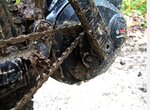

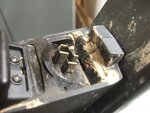
The outcome of chain suck like that shown above is that the chain gets locked and the cranks stop turning and the rider is forced to stop pedaling at short notice. I'm sharing this because it's interesting and might be good feedback for Bosch on future design considerations or individual riders who go into mud and might encounter a similar outcome. In my opinion, rigorous terrain is bound to impact ride quality and I'm not surprised that something like this could happen but I can see how it might adversely impact a rider (they could bump their knee or have a foot slip off the pedal and scrape a shin).
Thankfully, the second issue I've heard about recently has less impact on ride quality. Apparently the Bosch Nyon display panel has a plastic bevel which gets narrow along the top and the plastic has cracked for some people (and not on impact... just as the result of being brittle or expanding and contracting due to temperature). The details on how this happens are sparse, one person said they just left the display on their counter over night and in the morning it was cracked like this:
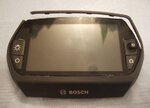
That's about it, I'm just sharing these independently and opening up for discussion from Bosch, individuals or manufacturers that use Bosch so the product can get better or people can learn how to maintain it more effectively to avoid issues. I still thing it's an amazing system and have not had any issues with the Intuvia display that's sold in the US (apparently the Nyon is coming in 2016). Maybe there will be some updates to the design before we get it.
Instead of repositioning pivot points on frames to deal with the pedal kickback issues (which would make frames longer and change their handling dynamic) some full suspension ebikes like the Haibike FS 27.5" have introduced a chain routing system called a Sprocket Equalizing System (S.E.S.) that's basically a pulley wheel which link the chain up and around the pivot point. This seems pretty reasonable to me, here's a picture of the SES system from Haibike which also seems to double as a guide to reduce chain drops in rough terrain:The small Bosch sprocket whirls 2.5 times faster than the crank revolves. This has several big advantages where ground clearance, weight and motor performance are concerned. However, this small sprocket is not compatible with a standard suspension frame chassis, as the lower chain position produces too much pedal kick back with standard position pivot points.

Okay, so this discussion is just setting the stage for one issue that my friend has experienced. Apparently in muddy situations he has found that the smaller chain ring and associated guide don't provide the necessary space or separation to avoid chain suck (which is when the bottom portion of the chain sticks to the sprocket and gets pulled up... possibly back into the top of the cog where the top portion of the chain is feeding in). He shared a picture with me recently and to be fair, since the sprockets are all made by the manufacturer and not Bosch, this may be a result of both the smaller mountain bike speck that Bosch recommends in their sizing guideline or simply the way the sprocket was made or possibly the addition of the small chain guide that hugs the front sprocket? Maybe the teeth on this particular sprocket were tighter than necessary? I discovered recently that Haibike actually uses a pattern of narrow to wide teeth that match the same pattern on the chain (it has narrow and wide slots from one link to the next) designed to reduce slipping and possibly avoid this type of issue. Here's the picture he shared from a Bosch powered electric bike that was being tested off-road along with another shot of the battery interface where some mud was leaking in.



The outcome of chain suck like that shown above is that the chain gets locked and the cranks stop turning and the rider is forced to stop pedaling at short notice. I'm sharing this because it's interesting and might be good feedback for Bosch on future design considerations or individual riders who go into mud and might encounter a similar outcome. In my opinion, rigorous terrain is bound to impact ride quality and I'm not surprised that something like this could happen but I can see how it might adversely impact a rider (they could bump their knee or have a foot slip off the pedal and scrape a shin).
Thankfully, the second issue I've heard about recently has less impact on ride quality. Apparently the Bosch Nyon display panel has a plastic bevel which gets narrow along the top and the plastic has cracked for some people (and not on impact... just as the result of being brittle or expanding and contracting due to temperature). The details on how this happens are sparse, one person said they just left the display on their counter over night and in the morning it was cracked like this:

That's about it, I'm just sharing these independently and opening up for discussion from Bosch, individuals or manufacturers that use Bosch so the product can get better or people can learn how to maintain it more effectively to avoid issues. I still thing it's an amazing system and have not had any issues with the Intuvia display that's sold in the US (apparently the Nyon is coming in 2016). Maybe there will be some updates to the design before we get it.
